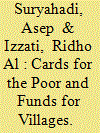|
|
|
Sort Order |
|
|
|
Items / Page
|
|
|
|
|
|
|
| Srl | Item |
| 1 |
ID:
160542


|
|
|
|
|
| Summary/Abstract |
When President Joko “Jokowi” Widodo took office in 2014, Indonesia was facing stagnating poverty and high inequality. To address these problems, he quickly introduced several initiatives, mainly in the form of social assistance programmes which gave the poor access to education and health services, as well as food and cash transfers, and grants for villages as mandated by the Village Law. This paper assesses the implications of these initiatives on poverty and inequality, by correlating economic growth with real per capita household consumption growth by quintile at the district level. The results indicate that economic growth has become less pro-poor during the first three years of the Jokowi government. This is indicated by lower growth elasticity of consumption of the poorest 20 per cent of the population, while those of the middle quintiles have increased significantly and that of the richest 20 per cent remains the highest. This suggests that Jokowi’s poverty and inequality reduction strategy is not sufficient. A complementary approach to connect the poor to economic growth—through job creation and income generation—is needed. Furthermore, the findings also show that it is important to pay more attention to assist the livelihood of the poor who live in Java as well as the urban poor.
|
|
|
|
|
|
|
|
|
|
|
|
|
|
|
|
| 2 |
ID:
181829


|
|
|
|
|
| Summary/Abstract |
Since the launch of Indonesia’s decentralization reforms in 2001, the country has achieved significant progress in improving the welfare of its citizens—as seen from increasing income per capita and decreasing poverty levels. However, vertical inequality has increased, raising concerns whether inequality between different parts of the country has also grown. Using spatial econometric models with data covering the 2002–19 period, this paper examines whether there has been a convergence or divergence in income per capita, inequality and poverty across local government areas in Indonesia. The findings indicate that there has been a conditional convergence of these development outcomes across local government areas. This means that the levels of income per capita, inequality and poverty across the country’s municipalities and regencies will converge, but the gaps will not be completely eliminated due to differences in their endowment factors. This conditional convergence occurs across municipalities and across regencies as well as across local government areas in Java and outside Java, but at different rates of convergence. This finding implies that Indonesia needs to maintain its decentralization policy and resist efforts to recentralize revenue sources and responsibilities. In addition, this should be complemented by efforts to assist areas with low income per capita, high inequality and high poverty rates to improve their endowment factors and institutions.
|
|
|
|
|
|
|
|
|
|
|
|
|
|
|
|
| 3 |
ID:
098941


|
|
|
|
|
|
|
|